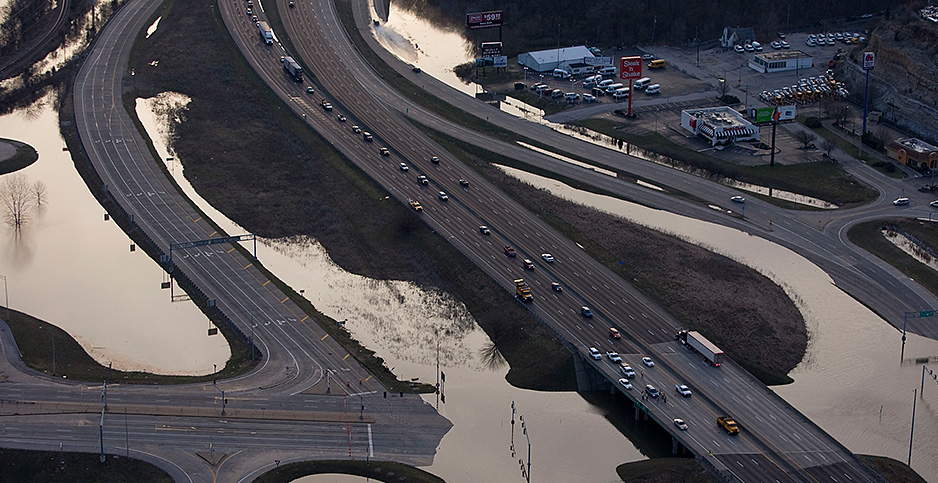It was an innocuous error that President Biden made on his first day in office — and that he has now corrected, to the relief of climate advocates.
When Biden issued an expansive day one executive order on climate change and public health, it included a little-noticed provision that intended to reinstate a flood-mitigation policy that President Obama had established in 2015 and President Trump revoked in 2017.
But in April, White House attorneys determined that Biden’s order had not actually reinstated the Federal Flood Risk Management Standard. The standard would require new federally funded projects located in flood zones to be built to withstand climate impacts such as sea-level rise.
Biden’s latest executive order on climate change, signed Thursday, corrects the earlier mistake and officially puts the flood standard in place.
“It’s an excellent move,” said Joel Scata, a water and climate attorney at the Natural Resources Defense Council.
“A great step,” said Chris Brown, executive director of SmarterSafer, a coalition of environmental, taxpayer and insurance groups that promotes disaster resilience.
A White House official confirmed to E&E News that Biden had reinstated the standard in his latest executive order, which primarily requires federal agencies to assess the economic threat that climate change poses to the U.S. financial system.
Biden’s action came days after three Democratic senators introduced legislation that would codify the flood standard as law, making it harder for a subsequent administration to overturn.
And it comes as the Biden administration is proposing to spend about $2 trillion in federal taxpayer money on infrastructure projects — the type of projects that could be subject to the new flood standard if agencies can implement the measure quickly enough.
“If you’re going to invest these types of funds, they’ve got to be able to withstand the changing climate, and they’ve got to be able to better withstand flood risk,” Brown said.
The standard will require new buildings and facilities built with federal money in flood-prone areas to be elevated 2 to 3 feet above projected flood levels or to have equivalent flood protection. It applies to projects such as subsidized housing, EPA-funded water and sewer plants, roads and bridges financed by the Department of Transportation, and infrastructure rebuilt with Federal Emergency Management Agency disaster funds.
The standard could increase construction costs by about 2% to 3%, but Scata of the NRDC said it will save money and possibly lives in the long term by preventing the projects from sustaining flood damage.
“Building to the climate of the past is no longer tenable,” Scata said.
Climate advocates had made reinstating the flood standard a top priority after Biden’s election in November.
Sen. Chris Van Hollen (D-Md.) said in a statement that his bill to establish a federal flood standard will ensure that U.S. infrastructure is “resilient enough to better withstand the current and forthcoming challenges of climate change.” The other sponsors are Democratic Sens. Brian Schatz of Hawaii and Cory Booker of New Jersey.
The three senators introduced similar legislation in September 2017, one month after Trump revoked the standard that Obama had established through an executive order. The bill garnered no additional sponsors and received no action in the Senate Banking, Housing and Urban Affairs Committee. A companion bill in the House, sponsored by Rep. Jamie Raskin (D-Md.), also died in a committee.
SmarterSafer’s Brown said the legislation could generate additional support as lawmakers consider massive spending on infrastructure projects.
“When we’re talking about spending this amount of money, we cannot continue to chase good money with bad. That’s something that resonates with taxpayers and taxpayer advocates around Washington,” Brown said.
SmarterSafer’s sponsors include groups such as the National Taxpayers Union, Taxpayers for Common Sense and the Coalition to Reduce Spending, as well as insurers and environmental groups.
Although Biden’s executive order is effective immediately, the flood standard could take years to implement because federal agencies will have to adopt rules that explain how the standard is to be applied.
After Obama established the flood standard through executive order in January 2015, agencies including EPA, HUD and FEMA began a rulemaking process that stopped abruptly in August 2017 when Trump revoked the standard.
Agencies that started rulemaking previously could potentially reintroduce the rules they were working on in 2017. That would be faster than starting from scratch, Scata of the NRDC said.
It’s not clear what caused the White House to decide last month that Biden’s day one executive order failed to reinstate the flood standard. The wording of the order confused many people, including Craig Fugate, who ran FEMA under Obama, because it said only that Biden was revoking Trump’s executive order that revoked Obama’s order establishing the flood standard.
Biden’s latest executive order is more explicit. It says the Obama order “is hereby reinstated, thereby reestablishing the FFRMS” — the acronym for the flood standard.
Read the full article from E&E News here.

